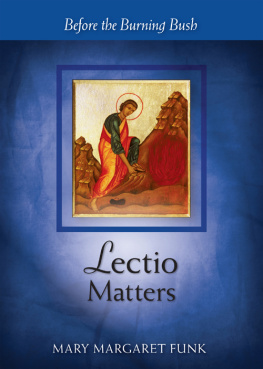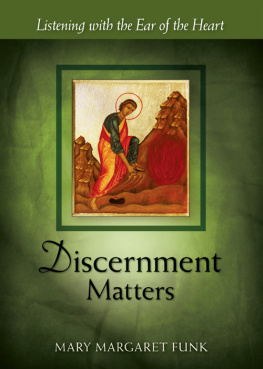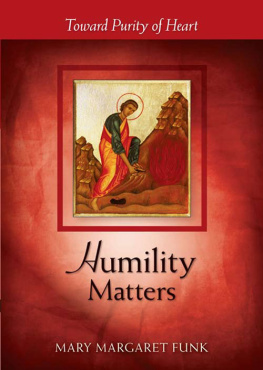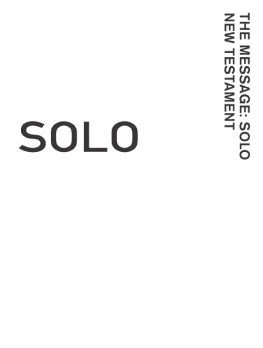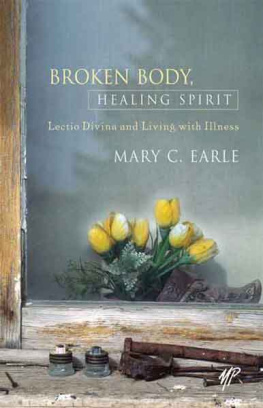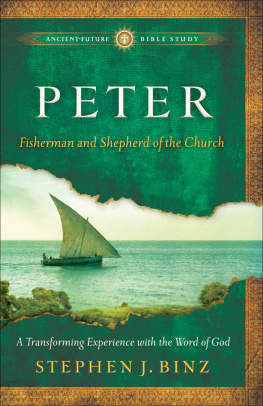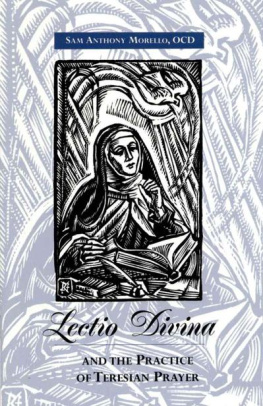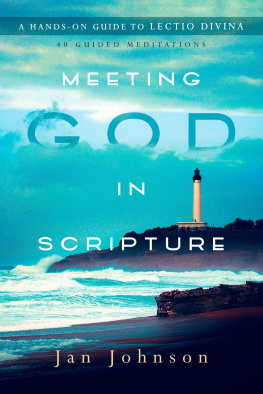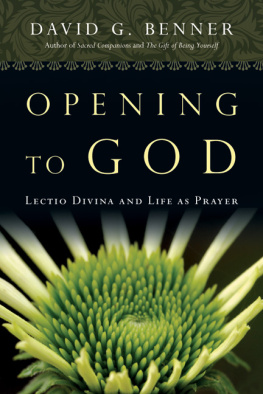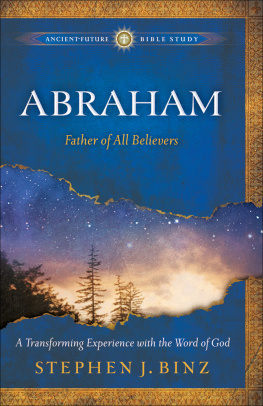LECTIO MATTERS
Matters Series
Thoughts Matter: Discovering the Spiritual Journey
Tools Matter: Beginning the Spiritual Journey
Humility Matters: Toward Purity of Heart
Lectio Matters: Before the Burning Bush
Discernment Matters: Listening with the Ear of the Heart
Lectio Matters
Before the Burning Bush
Mary Margaret Funk, OSB

LITURGICAL PRESS
Collegeville, Minnesota
www.litpress.org
Deep gratitude to our prioress, Sister Juliann Babcock, OSB; my Benedictine community of Our Lady of Grace Monastery in Beech Grove, Indiana; and my Irish Cistercian sisters, Abbess Marie Fahy, OCSO, and nuns of St. Marys Abbey in Glencairn, County Waterford. This set revision of the Matters Series is because of the vision and competence of Hans Christoffersen and staff at Liturgical Press, Collegeville, Minnesota.
Cover design by Jodi Hendrickson. Cover image: Moses at the Burning Bush, by Eastern Orthodox Nun Rebecca Cown of New Skete, Cambridge, New York. Commissioned by Pamela Farris. Based on an original at the Monastery of St. Catherine, Mount Sinai, Egypt. Used by permission.
Excerpts from the English translation of Rite of Penance 1974, International Commission on English in the Liturgy Corporation (ICEL); excerpts from the English translation of The Roman Missal 2010, ICEL. All rights reserved.
From A Better Wine , edited by Kevin Culligan, OCD, copyright Washington Province of Discalced Carmelites, Inc., ICS Publications, 2131 Lincoln Road, NE, Washington, DC, 20002-1199; www.icspublications.org.
Book of Jonah , trans. Abbot Laurence OKeefe, OSB, St Augustines Abbey, Ramsgate, Kent, CT11 9PA, England, 2009.
Story of Lectio of Experience by Kathleen Cahalan, PhD.
Scripture texts in this work are taken from the New Revised Standard Version Bible 1989, Division of Christian Education of the National Council of the Churches of Christ in the United States of America. Used by permission. All rights reserved.
2013 by Order of Saint Benedict, Collegeville, Minnesota. All rights reserved. No part of this book may be reproduced in any form, by print, microfilm, microfiche, mechanical recording, photocopying, translation, or by any other means, known or yet unknown, for any purpose except brief quotations in reviews, without the previous written permission of Liturgical Press, Saint Johns Abbey, PO Box 7500, Collegeville, Minnesota 56321-7500. Printed in the United States of America.
The Library of Congress has cataloged the printed edition as follows:
Library of Congress Cataloging-in-Publication Data
Funk, Mary Margaret.
Lectio matters: before the burning bush / Mary Margaret Funk, OSB.Revised edition
p. cm.
Includes bibliographical references (pages ).
ISBN 978-0-8146-3505-6 ISBN 978-0-8146-3491-2 (e-book)
1. BibleReading. 2. BibleDevotional use. 3. Bible OTDevotional use. I. Title.
| BS617.F86 2012 |
| 224.9206dc23 | 2012039187 |
To my guardian angel,
Brigid Funk,
who shows up from time to time
when lectio matters!

Moses at the Burning Bush, by Eastern Orthodox Nun Rebecca Cown of New Skete, Cambridge, NY, commissioned by Pamela Farris, based on an original at the Monastery of St. Catherine, Mount Sinai, Egypt
Iconographers Preface
Rebecca Cown
By means of all created things, without exception ,
The Divine assails us, penetrates us, and molds us.
We imagine it as distant and inaccessible.
In fact, we live steeped in its burning layers.
Teilhard de Chardin
O ne of the pillars of spiritual teaching in Eastern Christianity is deification (Greek: theosis ), We call this the light of discernment. Another term is aesthesis , a Greek word difficult to translate into English, which we may understand as inner perception or divine sensation: a spiritual sense. Our innermost spiritual senses need to be made conscious and honed and practiced in our daily lives.
Our earliest Christian teachers reiterated that God became human in order that the human person may become God. This divine gift presupposes our personal and collective inner work, our synergy with God. This potential has been present from the very beginning, according to the account in Genesis, since we are created in the image and likeness of God. The image is the reflection of God. One commentary on this Genesis passage says that likeness refers to being endowed with discernment and understanding. So, by inference, we might say that the likeness is what we are called to bring into reality by inner discernment.
St. Gregory of Nazianzus says, Whatever is not consciously embraced cannot be transformed. That is, unless we awaken to this divine reality in our hearts, to who we really are and to what we are called, we cannot engage with this Divine Spirit within, and it will remain dormant. We are personally called to be transformed and transfigured into our God-likeness, but not just for ourselves; we are called personally to become Gods agents and to enable Gods ongoing creation of this world of ours.
God has no other hands, feet, eyes, mind, or heart than ours to continue Gods creating. The Spirit of God is everywhere present and filling all things, and human beings have been called to cocreate with God. The raw materials, so to speak, need our working with God to bring about life, harmony, peace, justice, and beauty out of chaos and disorder. God has given us the mission and purpose of incarnating Gods very first wordsLet there be Lightand to make it a living reality in our lives.
The story of Moses before the burning bush may well be a paradigm of every persons divine visitation or awakening to the divine presence. If heeded, this encounter will change a persons life. This change, or metanoia (Greek for change of heart, change of purpose, direction), moves us away from our former identity, where the ego is in control, to become an instrument in Gods hand. This is what happened to Moses, who once was a Hebrew slave, saved by an Egyptian princess. He was raised and educated as an adopted prince but later, having slain an Egyptian overseer, fled for his life into a foreign land and then became a shepherd. After many years in this lonely desert, God revealed to Moses his true identity and purpose in life.
The story tells us that Moses was tending the flock of Jethro, his father-in-law, and led the flock to the far side of the desert. He came to Horeb, the mountain of God. There, the angel of the Lord appeared to him in flames of fire from within a thorn bush. Moses saw that, although the bush was on fire, it was not consumed. So Moses thought, I will go over and see this strange sightwhy the bush is not burnt. When the Lord saw that Moses had gone over to look, God called to him from within the bush: Moses! Moses!
And Moses said, Here I am.
Do not come any closer, God said. Take off your sandals, for the place where you are standing is holy ground. Then he said, I am the God of your father, the God of Abraham, the God of Isaac, and the God of Jacob. At this, Moses hid his face because he was afraid to look at God.
The icon on the cover of this book depicts this encounter. Several aspects of the icon highlight our journey toward discernment. First, the bush is actually a thorn bush, typical of the desert, indicating that there isnt any place where God cannot be encountered! Next, we see the blackened sandals behind Moses. Sandals are made of the skin of animals; they are dead skins, indicating the passing nature of our persona, our identity in this world. Moses puts behind him his sense of who he has been; without it, he is vulnerable and full of fear. Yet, the icon manifests his readiness to follow the call into an unknown, to a mysterious and awesome divine encounter. His ego identity is not in control. The icon also indicates a change in his consciousness of who he really is. His clothing is radiant with divine light. His ego is not obliterated but participates in the Light of God. He has awakened to the divine spark within, to his true identity in God. His inner senses are illumined, awakened, and he hears the voice of God telling him to lead his people out of Egypt.

